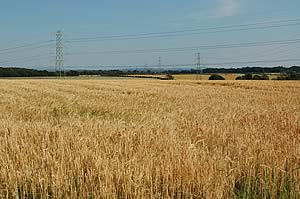 |
|||||||||
|
|||||||||||||||||||
|
|
Traditional landscapes are changing
says Natural England England’s unique and varied landscapes are changing says a new report launched today.
From the hop fields and apple orchards of Kent, to the grazing pastures of Somerset dairy herds, the quality of England’s landscape is changing when judged against seven criteria such as woods, hedges and dry stone walls, rivers, farming, wild open spaces and housing developments. The ”Tracking Change in the Character of the English Landscape” report produced by Natural England, English Heritage and Defra, monitored changes in the English landscape between 1998 and 2003. Of England’s 159 Joint Character Areas (JCAs)
Some of the changes are due to agricultural changes such as fewer animals grazing pasture and new crops being planted. Other changes are due to development; for example, in the flat, wide valleys of the Trent Valley Washlands new business parks and housing are being built alongside major routes such as the A38, A5 and A50. The rate of change is accelerating along motorways and trunk roads (see map A) as urban corridors develop along the M1, M3, M4, M5, M6 and the A14. New development hot spots in traditionally rural areas such as Cumbria, North Yorkshire, and South Devon suggest that pressures from commuting lifestyles now extend beyond major towns and cities. Dr Helen Phillips, Chief Executive of Natural England, said: “Some of our treasured landscapes are suffering from decline and neglect. We want to celebrate the countryside’s local accent such as honey coloured dry stone walls in the Cotswolds and the hedgerows of the Midlands. “Where Natural England can target agri-environment schemes and grants to make this happen on Sites of Special Scientific Interest, farms and in partnership with National Parks and Areas of Outstanding Natural Beauty it is fairing well. The Countryside Quality Counts indicators allows us to monitor change and to identify the pressures causing it that will help guide policies to help ensure that the wider countryside does not slip away quietly unnoticed and unmourned.” Landscape character is an important aspect of the overall quality of the countryside and a key contributor to people’s quality of life. Natural England, working together with top academics from the Universities of Nottingham and Sheffield, supported by communications specialists, Countryscape, devised a set of criteria to assess what is changing, and whether change matters to people. The research was jointly sponsored by English Heritage. Stephen Trow, Head of Rural and Environmental Policy for English Heritage, said: “Change in the countryside is inevitable and necessary, but needs to be planned and managed so that we pass on to a future generations a diverse and attractive landscape in which history can still be understood and enjoyed. “The historic character of the landscape is absolutely fundamental to its beauty and we must be concerned if this character is needlessly eroded. Countryside Quality Counts gives us a powerful new tool for understanding the process of change and for helping us to decide how to respond to it.” Barry Gardiner, Minister for Biodiversity, Landscape and Rural Affairs welcomed the report saying: “The way we manage our landscape is important to people’s quality of life. It is good to see that over 61% of England’s Joint Character Areas have maintained or enhanced their character. Nearly 50% of farmland is being maintained under our Environmental Stewardship Scheme, which will contribute to improving the landscape. We look forward in working with Natural England to explore what else can be done. The results will be used to inform future government policy, to help ensure that development in rural areas is sustainable.” The picture is brighter in some of the best loved and protected areas of England from the Lake District to the Cotswolds. Our National Parks and Areas of Outstanding Natural Beauty are included within the top ten per cent of Joint Character Areas where landscape quality has improved since 1998 and 2003, when judged on seven key criteria, from woodland cover to river quality.
The development of the Countryside Quality Counts method has provided a scientific measure of countryside quality can be used to monitor change and to identify the pressures causing and this will help guide policies to ensure that what people love about the English countryside is conserved and enhanced.
|
||||||||||||||||||

|
|
||||||||||||||||||
| home | agri-services | pedigree
pen | news | dairy | beef | machinery property | organisations | site map |
|||||||||||||||||||

